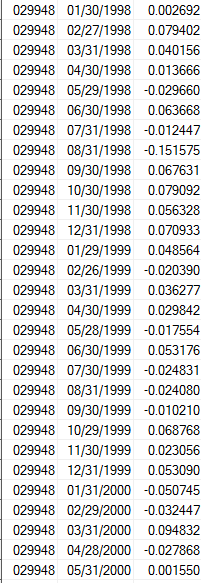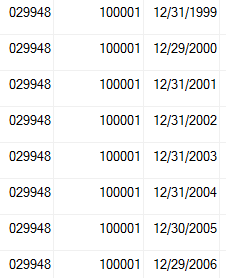- Home
- /
- Programming
- /
- SAS Procedures
- /
- Re: Matching two data files
- RSS Feed
- Mark Topic as New
- Mark Topic as Read
- Float this Topic for Current User
- Bookmark
- Subscribe
- Mute
- Printer Friendly Page
- Mark as New
- Bookmark
- Subscribe
- Mute
- RSS Feed
- Permalink
- Report Inappropriate Content
Hoi, Can someone please help me, how can I merge this two file by matching the ID and the year (not the the whole date)? I don't know how i can take only the year part of the date.
File 1:
ID Date value1

File 2:
ID N Date value2


So I would have something like:
ID Date N Value1 value2
...
029948 12/31/1998 100001 0.070933 0.006000
| 029948 | 01/29/1999 100001 | 0.048564 | 0.006000 |
....
029948 12/31/1999 100001 0.053090 0.006000
| 029948 | 01/31/2000 100001 | -0.050745 | 0.005200 |
thank you very much!!!
Accepted Solutions
- Mark as New
- Bookmark
- Subscribe
- Mute
- RSS Feed
- Permalink
- Report Inappropriate Content
YEAR is a function that you apply to a variable. So the syntax for your where clause should be
year(a.date) = year(b.date)
The syntax that you tried looks more like a method call for an object oriented programming language like PHP.
- Mark as New
- Bookmark
- Subscribe
- Mute
- RSS Feed
- Permalink
- Report Inappropriate Content
Use the year() function
- Mark as New
- Bookmark
- Subscribe
- Mute
- RSS Feed
- Permalink
- Report Inappropriate Content
I have try this but it did not work
proc sql;
create table want as
select *
from file1 as a left join
file2 as b
on a.id=b.id and a.year(date)= b.year(date);
quit;
- Mark as New
- Bookmark
- Subscribe
- Mute
- RSS Feed
- Permalink
- Report Inappropriate Content
YEAR is a function that you apply to a variable. So the syntax for your where clause should be
year(a.date) = year(b.date)
The syntax that you tried looks more like a method call for an object oriented programming language like PHP.
- Mark as New
- Bookmark
- Subscribe
- Mute
- RSS Feed
- Permalink
- Report Inappropriate Content
thanks, it works. may i have one additional question. if i want it also to take the first (year) available value or the latest available value. eg. above, 1998 is not available in file2 but it is available in file1 so i want to match all the observations in 1998 from file1 with the first (year 1999) in file 2 how can i do that?
- Mark as New
- Bookmark
- Subscribe
- Mute
- RSS Feed
- Permalink
- Report Inappropriate Content
You could try: (not tested)
on a.id=b.id
group by a.id, a.year(date)
having abs(a.year(date)-b.year(date))=min(abs(a.year(date)-b.year(date)) );
Haikuo
- Mark as New
- Bookmark
- Subscribe
- Mute
- RSS Feed
- Permalink
- Report Inappropriate Content
i have something like this
proc sql;
create table want as
select a.*, b.value2
from file1 as a left join
file2 as b
on a.id=b.id
group by a.id, year(a.date)
having abs(year(a.date)-year(b.date))= min(year(b.date)-year(a.date)) ;
quit;
but then all the data from 2000 onwards is exclude.
- Mark as New
- Bookmark
- Subscribe
- Mute
- RSS Feed
- Permalink
- Report Inappropriate Content
Hi,
If this is exact what you have run, then you need an additional abs(), like mentioned in my previous post:
having abs(a.year(date)-b.year(date))=min(abs(a.year(date)-b.year(date)) );
Good luck,
Haikuo
- Mark as New
- Bookmark
- Subscribe
- Mute
- RSS Feed
- Permalink
- Report Inappropriate Content
yes, thank you.
- Mark as New
- Bookmark
- Subscribe
- Mute
- RSS Feed
- Permalink
- Report Inappropriate Content
do you may know why i get more observation than the original file which i do not expect?
- Mark as New
- Bookmark
- Subscribe
- Mute
- RSS Feed
- Permalink
- Report Inappropriate Content
I can guess. As in general, if you get more obs than the master table after left join, it usually means you have more than one match per id, year(date). One way to find out how and why is to run something like the following query:
select * from want group by id, year(date) having count(*)>1;
Haikuo
- Mark as New
- Bookmark
- Subscribe
- Mute
- RSS Feed
- Permalink
- Report Inappropriate Content
thank you!
- Mark as New
- Bookmark
- Subscribe
- Mute
- RSS Feed
- Permalink
- Report Inappropriate Content
In addition to what Tom said, if you want to avoid the notes (and possibly assigning the wrong dates), change your select statement. i.e.:
proc sql;
create table want as
select a.*,b.value2
from file1 as a left join
file2 as b
on a.id=b.id and year(a.date)= year(b.date);
quit;
April 27 – 30 | Gaylord Texan | Grapevine, Texas
Registration is open
Walk in ready to learn. Walk out ready to deliver. This is the data and AI conference you can't afford to miss.
Register now and save with the early bird rate—just $795!
Learn the difference between classical and Bayesian statistical approaches and see a few PROC examples to perform Bayesian analysis in this video.
Find more tutorials on the SAS Users YouTube channel.
SAS Training: Just a Click Away
Ready to level-up your skills? Choose your own adventure.


